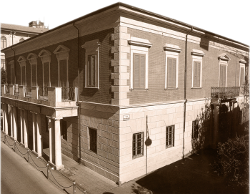You are in: Villa Paolina
Villa Paolina
 Around the 1820, Princess Paolina Bonaparte, Napoleon's sister, built a villa in Viareggio seaside, in immaculate territory of the Tuscany coast. Today the building houses the Museum A.C. Blanc.
Around the 1820, Princess Paolina Bonaparte, Napoleon's sister, built a villa in Viareggio seaside, in immaculate territory of the Tuscany coast. Today the building houses the Museum A.C. Blanc. The architecture of the Palazzo Paolina is based on the tension between nature and artifice, between the infinite horizon of the sea and the geometric shape of the defined built. The plan of the building is organized according to criteria in relation to the sea and the sun, the rooms are indeed distributed according to the climatic changes.
According to recovered letter written by Pauline, the designer of the building was Giovanni Lazzarini, character and scholarly knowledge of the culture's architectural footprint French.
The Viareggio's Paolina palace is inspired, to a lesser extent, to the Princess's villa in Rome. Lazzarini is strongly influenced by the taste of last one in the realization of the project. It involves the construction of a building compact on the outside and completely open in two wings on two floors to the inside. Just past the entrance court, the gaze is projected onto the garden facing the prospect of 'building.
The first of the two wings, facing the sea, enclose the apartment of the princess and of her guests; instead in the second, placed symmetrically to the first wing the environments for domestic staff, the main staircase and the dining room are derived. The body that joins like a bridge the two main wings, elevated on two floors, shelters only the large room of the first floor, below which the door for entry opens. A third wing, perpendicular to the other two, distributed on one floor is dedicated to the kitchen and finished in a more simple manner, with only four windows. On the front of the wing facing the sea, the elegant colonnade topped by a terrace stands.
The building reveals an interpretation of the theme of the Roman domus and represents a significant aspect in the panorama of French culture that is asserts to Lucca through academic institutions. There is an exchange between the archaeological rigor and architectural research and it is known thanks to some factors such as the colonnade of Doric and the color and material similarities with the ancient domus.
